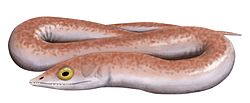| Megalichthys | |
|---|---|
 | |
| Restoration of M. hibberti | |
| Scientific classification | |
| Kingdom: | Animalia |
| Phylum: | Chordata |
| Clade: | † Megalichthyiformes |
| Family: | † Megalichthyidae |
| Genus: | † Megalichthys Agassiz, 1839 |
| Type species | |
| Megalichthys hibberti Agassiz, 1839 | |
| Species | |
| |
Megalichthys is a genus of prehistoric lobe-finned fish which lived during the Devonian and Carboniferous periods. [1] It is the type genus of the family Megalichthyidae. The type species is M. hibberti. [2] The species M. mullisoni, named for fossil preparator C Frederick Mullison, is known from the Catskill Formation of Pennsylvania. [3]





